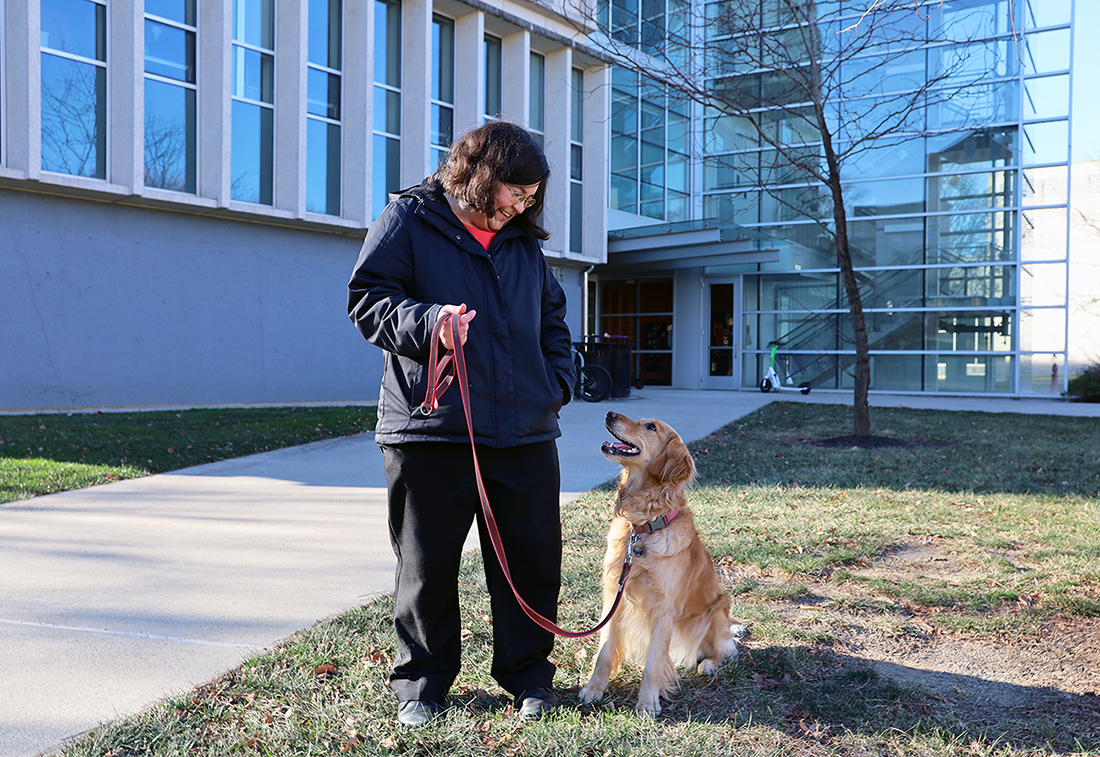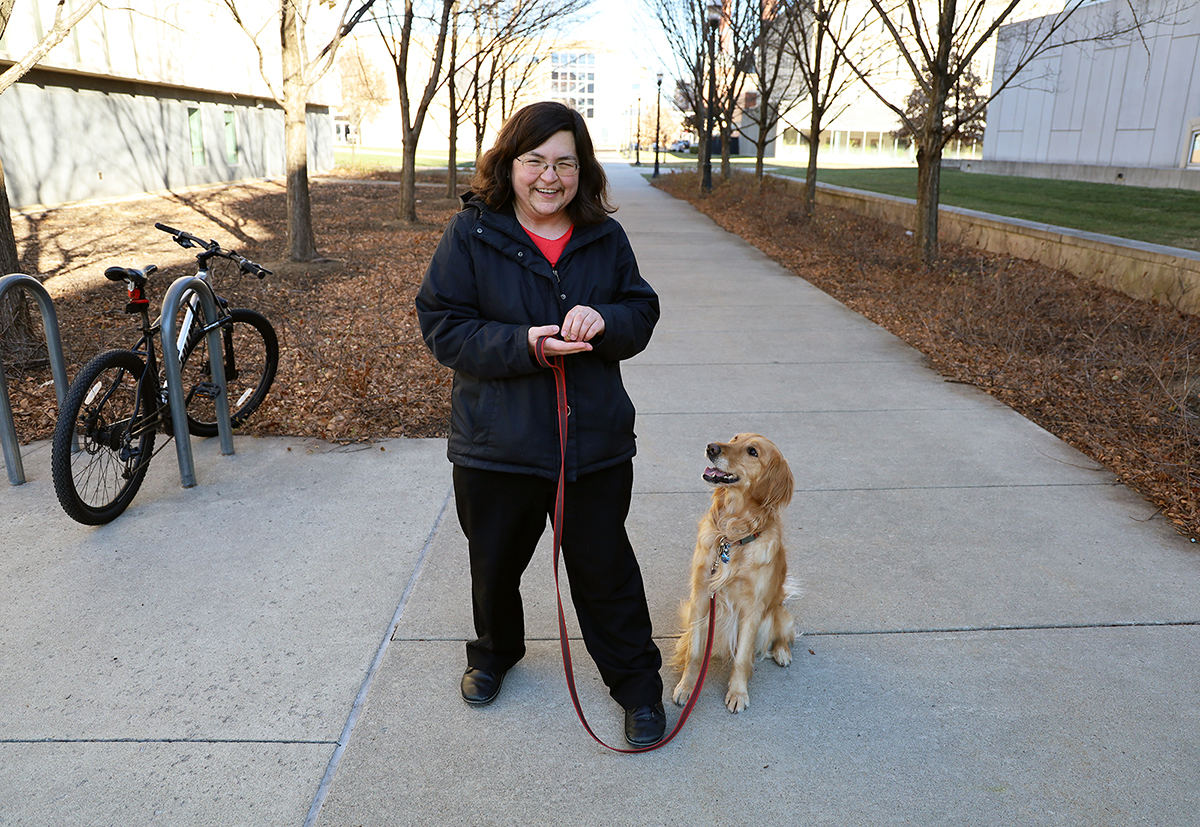A biostatistician’s best friend
CPH’s Abigail Shoben brings her love for dog sports to research collaboration
By Kristen Mitchell

Associate Professor Abigail Shoben is an expert biostatistician and a lover of dogs. Through a research partnership with the Ohio State University Veterinary Medical Center, she found a way to unite those passions.
Shoben got her first puppy, a Pembroke Welsh corgi named Toby, in 2011 during her first year at Ohio State. Together they discovered dog agility — an athletic feat where trainers direct canines through a series of obstacles, the pups jumping and navigating through tunnels along the way. Shoben quickly grew to love dog sports as space to build community outside academia and support Toby’s behavioral needs.
A few years later when she added Echo, a golden retriever, to her family she introduced her to agility and hoped to eventually compete. Unfortunately, Echo’s veterinarian diagnosed a permanent back condition when the dog was less than two years old, limiting her athletic prowess.
Shoben reached out to Arielle Markley, assistant professor and canine sports medicine and rehabilitation veterinarian at the Veterinary Medical Center, for assistance in managing Echo’s condition in 2018. During weekly appointments the two got to talking about their shared interest in agility, the challenges that come with pet injuries and the knowledge gaps that left families with lingering questions about caring for their dogs.
“We started talking about, could we do a survey of people who do agility with their dogs and see what sorts of injuries have occurred?” Shoben said.
From there, the duo became close friends and scientific collaborators.

Echo emotes outside Cunz Hall.
Central Ohio is a hotbed for dog agility with several world class four-legged athletes living in the region, Markley said. As a result, she regularly sees agility animals in her rehabilitation work. Without much existing data cataloging common agility injuries, she knew it would be a good starting point for her own research.
Shoben and Markley sent a survey to owners of agility dogs around the world in 2019, asking them to report the different kinds of injuries and conditions their dogs have experienced. Shoben helped develop the survey questions and analyze the data, which has led to four published papers with more in the works.
The first paper, published last year, cataloged the types of injuries experienced by agility dogs with a focus on breed and geographic differences. Based on data from more than 4,700 dogs, the research team found that injuries to a pup’s shoulder are most common, and that border collies had a significantly higher chance of sustaining an injury compared to other breeds.
“One theory is that they are going faster — they are very active. They might ignore pain because they like going fast,” Shoben said.
Another paper described risk factors associated with training and competition. The team found that starting jump training at a young age was associated with greater injury risk compared to starting after 18 months. Shoben said it’s been rewarding to share this research informally with friends and provide data-backed suggestions for training and injury prevention.
“It’s been fun for me to see all of my interests coalesce into one project,” she said. “To work on something I was interested in as a totally separate personal hobby and be able to combine that with my intellectual and professional interests has been really exciting.”

Shoben gives into Echo's demands for treats outside Cunz Hall.
Shoben’s inside knowledge of the sport had a major impact on the success of initial survey and subsequent published analysis, Markley said.
“It's been a great collaboration,” she said. “I wish all veterinary researchers had access to the kind of expertise that she has, because it's definitely made the research way better, more fun and a lot easier than if I were trying to slog through it on my own.”
Shoben and Markley will continue to publish analyses stemming from their initial survey and are exploring new lines of inquiry, including research to evaluate the impact of different surfaces for a big national agility event where dogs run on dirt, grass and sand.
“People competing in agility have strong opinions about what surface their dog runs best on,” Shoben said. “There’s no data on any of it. It’s cool to get that started.”
As for Echo: retired from the physical demands of agility work, the six-year-old pooch keeps her senses sharp. She focuses on nose work, a dog sport modeled after drug detection dogs that requires competitors to sniff out hidden scents. She successfully competed in a national event in June, finishing with a top ranking among her peers.
About The Ohio State University College of Public Health
The Ohio State University College of Public Health is a leader in educating students, creating new knowledge through research, and improving the livelihoods and well-being of people in Ohio and beyond. The College's divisions include biostatistics, environmental health sciences, epidemiology, health behavior and health promotion, and health services management and policy. It is ranked 22nd among all colleges and programs of public health in the nation, and first in Ohio, by U.S. News and World Report. Its specialty programs are also considered among the best in the country. The MHA program is ranked 5th and the health policy and management specialty is ranked 21st.